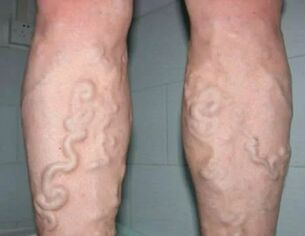Easy walking, long walks without fatigue even in the heels, beautiful ankles and hips that you do not want to hide from others - these are the benefits of healthy legs without signs of venous diseases. The way and rhythm of life gradually changes if a person neglects the prevention of varicose veins.
This is true for both women and men. The disease develops in different ways, and the stages of varicose veins in medicine always provoke a discussion regarding the identification of the patient. But you need to understand the classification so as not to miss the moment when varicose veins are treated without surgery.
Problem essence
Varicose veins are disorders of blood flow in the saphenous veins. Due to problems with the venous valves, which must retain parts of the blood to travel further to the heart, the plasma flows in the opposite direction and stagnates.
Pressure cannot push blood through the veins of the lower extremities, leading to stretching of the walls. A pattern of stripes and zigzags of a blue hue gradually appears on the legs, complemented by swelling and a bulge in an advanced stage.
But varicose veins are not immediately noticeable. The problem can progress without visual symptoms, so people who feel discomfort in their legs but do not find bulging veins attribute the discomfort to fatigue.
Varicose veins do not appear on their own as a separate disease. This is just a symptom of dysfunction of the vascular system as a whole, which appears even in youth. It is wrong to consider varicose veins of the lower extremities as a sign of old age. Many girls in their 20s hide their legs under pants and long skirts because of varicose veins.
There are various reasons for a circulatory system malfunction:
- Genetic inheritance from parents. If mom (most often) or dad have problems with the outflow of blood from the legs to the heart, children should undergo an examination and prevention of the vascular and venous systems. But genetics does not work in all cases, if there is no motivating factor - a sedentary or standing lifestyle due to the peculiarities of the profession, unbalanced diet, diseases with complications;
- Ignoring the rules of technical break when hiring in certain areas of work, where there is a large load on the legs, but no movement (hairdresser, sales specialist, accountant, programmer, driver). Warming the feet every 30 minutes prevents blood stagnation;
- Some health problems affect blood vessels and veins - diabetes mellitus, heart disorders, leg, spine, obesity injuries;
- Pregnancy is a trigger for many women for the first symptoms of varicose veins. The embryo not only increases the weight of the future mother, which creates stress on the legs, but also puts pressure on the internal organs and vital systems of the pregnant woman.
Varicose veins are a serious signal of internal problems that have not been declared, but require at least a standard examination by a therapist.
Different stages of development of venous insufficiency
Despite the fact that veins in humans are localized not only on the legs, but also in the whole body, varicose veins of the lower extremities are more common. Both women and men suffer from this disease, but a higher percentage of the beautiful half of the population.
There are several stages of varicose veins that are classified according to severity.The division is conditional, so the treating physician makes the diagnosis and knows which treatment regimen to prescribe to the patient for certain complaints.
There are a number of varicose vein stage classifications among medical professionals. The international community identifies seven stages of varicose veins, drawing a line within narrow symptoms. But in practice, varicose veins are diagnosed in 3 stages of disease gradation:
- First degree (compensation phase) - worsening of blood flow from the legs to the heart is predetermined by lifestyle or genetics, but the patient has time to return the venous valves to normal functionality. The symptoms of varicose veins in the initial phase are mild and are not taken seriously;
- Second degree (subcompensation) - there are visual signs of venous insufficiency, which are difficult to confuse with other changes. The discomfort in the legs disappears after a long rest or is constantly followed. At this stage, patients usually seek help from a doctor. Vascular and venous changes are significant, but it is possible to relieve tension and pain from the lower extremities;
- The third degree (decompensation) is the last stage of varicose veins, when the thinned walls of the vascular system begin to burst from excess blood. Skin tissues do not receive food and die. An ulcer develops on the skin that is difficult to treat. In some cases, in grade 3 varicose veins, the bacteria join the ulcerative foci. Stabilizing the patient's condition requires time, effort, and complex therapy.
The above stages of varicose veins are a conditional division. Within each group of venous insufficiency, there is a mild, moderate and severe degree of the disease, which is determined by the symptoms described by the patients at the reception. Based on the fact that the pathology of the veins is individual in each case, the line of transition from one phase to another is insignificant, especially in cases of 1 and 2 degrees.
Features of the initial stage of pathology
Grade 1 varicose veins are diagnosed by a doctor in rare cases because people do not go to the clinic due to short-term edema or heaviness in the legs. Folk remedies help to relieve fatigue, the swelling goes away on its own after sleeping or changing high heels into slippers. Grade 1 varicose veins in many people do not go into the second phase until old age, if there is no provocative factor.
Changes in the circulatory system occur not only in adults, but also in modern adolescents, who are deprived of mobility and prefer the computer, phone and other devices to active entertainment.
Only the arms and brain are trained, and the rest of the body does not change position for a long time. Blood circulation slows down, especially in the lower part of the skeleton. Bent knees, crushed muscles, veins and blood vessels in the thighs, buttocks lead to stagnation.
Teenagers often complain of leg pain and cramps. In some cases, edema is visible, especially in overweight. There are no clear symptoms of grade 1 varicose veins, but the initial phase has begun and its progressiveness depends only on the attention of children or their parents to themselves.
Teenage girls choose uncomfortable high-heeled shoes in an attempt to attract attention. The pressure in the veins of the lower extremities increases and leads to the initial degree of pathology. The impossibility of standing and moving in high heels deforms the feet, increases the load on the spine and bones of the legs, hip joints. Curvatures negatively affect vessels because they are compressed.
The initial stage of varicose veins in young people is not disturbing, because the symptoms disappear after rest or a little warming up. The signs of grade 1 varicose veins are as follows:
- Heavy legs even without physical activity;
- Slight swelling in the afternoon when the foot is too small to fit in the shoe or when the edges are noticeably buried in the skin. The symptom disappears in the morning if the legs have rested or a procedure has been performed to relieve swelling and muscle tension - vertical position of the lower limbs, foot baths, massage, changing uncomfortable shoes;
- Short-term convulsions in rare cases.
In rare cases, with varicose veins of the 1st degree, external signs of venous pathology appear - thin bands of veins or vascular network, which are under stress due to reduced blood flow rate.
It is difficult to diagnose the initial stage of pathology on your own, because these symptoms are also observed in other diseases, for example, diabetes mellitus, kidney problems. For diagnosis and treatment you should visit your doctor at the first signs of discomfort.
Varicose veins are localized not only on the legs, and the initial stage can be skipped if there are no changes in the lower extremities.
Level 2 Features
The initial phase of venous pathology in the absence of prophylaxis or therapy after some time passes into the phase of subcompensation. Symptoms of grade 1 varicose veins occur more often and last longer.
External changes appear on the skin - swollen veins or a large number of spider veins. At night, and even during the day, cramps occur, the patient feels pain and cannot move his leg. Hardware examination of the veins of the lower extremities reveals changes in the operation of the valve.
The pressure in the vessels rises, but it is difficult to push the blood without closing the valve. Blood stagnation is formed, which appears on the skin in the form of blue nodules.
- The symptom of stage 2 venous insufficiency is swelling that does not go away after rest and preventive procedures. Edema occurs due to the impossibility of raising blood through the veins, hemodynamics are weakened. The liquid part of the blood (plasma) begins to penetrate under the skin through the thinned walls of the veins and small vessels, because the function of its transport is impaired;
- Skin color changes due to poor circulation and nutrient intake. The cells of the epidermis get a brown tint, gradually turning black. Inflammation develops and, as a result, the initial stage of ulcerative formations;
- Patients who come to the doctor in stage 2 have complaints of severe pain, muscle numbness and itchy skin. The symptoms are caused by a lack of proper nutrition for the epidermal cells.
The varicose vein subcompensation phase is not considered hopeless if therapy is diagnosed and prescribed in a timely manner. If you find one or more signs of grade 2 varicose veins, you cannot engage in self-medication and listen to well-wishers. Only a doctor will help you deal with the problem.
Class 3 characteristics

People reach grade 3 venous insufficiency if treated carelessly and without due respect. The first stage of pathology in rare cases causes discomfort and changes the quality of life, but stage 2 venous insufficiency should not be inconspicuous in order to neglect a visit to the doctor and undergo a course of rehabilitation.
The 3rd degree of pathology is the most severe and the most dangerous, because trophic ulcers form, which do not heal even with medication. In the decompensation phase, the body has exhausted the ability to keep the veins in working order.
The walls are stretched to the limit and thinned, there is a risk of cracking with any injury. Another problem of grade 3 varicose veins is thrombophlebitis - blockage of a blood vessel, the formation of blood clots, which can separate and lead to death.
Venous insufficiency in extreme cases reaches its final stage. The reasons for such an attitude of people towards themselves are not clear. It is strange to endure pain, feel aesthetic discomfort and not be able to walk easily. Timely diagnosis of the problem and following the doctor's recommendations will not allow varicose veins to go through any stage of pathology.
After a detailed consideration of the classification of varicose veins of the lower extremities, it is worth noting that venous insufficiency occurs in other parts of the body and internal organs. Such a problem is harder to notice, but when discomfort occurs in the legs, venous blood flow disorders elsewhere can also be considered.
How to diagnose pathology
At the first signs of leg discomfort, you should contact a medical facility. The diagnosis and treatment of venous insufficiency is performed by a phlebologist, but initial consultations can be obtained from a therapist.
- A visual examination of the condition of the skin lining of the legs, the presence of orthopedic changes and other signs is performed;
- Palpation of problem areas not only of the legs but also of the groin and abdomen;
- Patient complaints are heard;
- A detailed medical history is compiled in the form of a survey interview. The questions are aimed at identifying the cause that has become the starting point in the formation of varicose veins;
- A referral for general blood and urine tests is required to determine the patient's general health;
- Functional test to determine the degree of dilatation of the veins (Schwarz, Perthes, sole test);
- In the case of varicose veins, a hardware examination of venous patency and the condition of the venous valves is performed - duplex ultrasound (DUS), plethysmography, phlebography, rheovasography.

After carrying out all measures for diagnosing venous insufficiency and determining the degree of varicose veins, prophylaxis, conservative therapy, treatment with alternative methods and, in extreme cases, surgery, laser pathology removal are prescribed.
How to deal with different degrees of venous dysfunction
The earlier you notice signs of varicose veins, the easier and faster you can deal with the problem. The initial phase of the pathology can be completely reversed without the use of medication if you start timely prevention:
- Change your rhythm and lifestyle. Often, the cause of blood flow disorders in the veins is a sedentary or standing lifestyle due to professional activities. Movement needs to be added to increase hemodynamics and prevent high blood pressure in some areas. With excess body weight, you should fight its normalization, but gradually;
- Choose comfortable and correct footwear. In the presence of orthopedic deformities, shoes are chosen taking into account this problem. High heels only on special occasions;
- Give up bad habits that cause problems in the circulatory system;
- Reduce weight if it is excessive and puts extra strain on your legs;
- Choose the right exercise to help your blood flow from your legs to your heart.
In the initial phase, the doctor prescribes venotonics, creams, tablets to reduce the load on the venous walls and restore their elasticity. The medical jersey must be adjusted individually to relieve tension in the legs.
When external signs appear that create aesthetic discomfort, a special composition (sclerotherapy) is introduced into the vein, but this is rarely at an early stage.
The second phase of venous insufficiency requires more attention so that the problem does not develop into phase 3. The specificity of removing the pathology of the 2nd degree is similar to the treatment of varicose veins in the initial phase. Medications are prescribed to reduce the risk of blood clots, reduce tissue swelling, and restore blood flow.

Surgical therapy of varicose veins of the 2nd degree is resorted to in the presence of obvious changes on the skin - convex veins, venous network, vascular pattern. Radiofrequency or laser therapy is performed in the treatment room. Shown including sclerotherapy, when the external defect disappears in the eyes after the injection at the site of the injection problem.
Compression garments are necessary to improve blood flow and reduce stress on the legs.
How to treat grade 3 varicose veins when the condition of the veins and tissues is in a terrible state and the body is unable to correct the situation? Treatment is only surgical to prevent thrombosis, rupture of veins and restore hemodynamics throughout the body.
Phlebectomy is usually performed - removal of the affected vessels. The operation is performed using surgical instruments (classic method) or a laser without a single incision (modern method of treating varicose veins of the 3rd degree).
The course of the disease is complicated by the formation of ulcers that do not heal even with drug therapy. Therefore, at this stage you cannot do without a surgeon. After a successful operation, an individual course of medication, dressings and medical cloth is selected.
In conclusion
Varicose veins are not a harmless cosmetic defect on the legs and other parts of the body, but a serious pathology that, with pardon, will turn a person's life into torment and constant walking to clinics.
The initial stage of venous insufficiency is characteristic of the majority of the population, but the diagnosis is rarely made due to people's ignorance of the possible consequences.
If professional activity involves an inactive image or a constant presence on the legs, there are examples of pathology in relatives, you need to take preventive measures and exclude the progression of the disease in the initial stage. Leaving the problem unattended, you may not notice how the veins will cause other pathologies.























